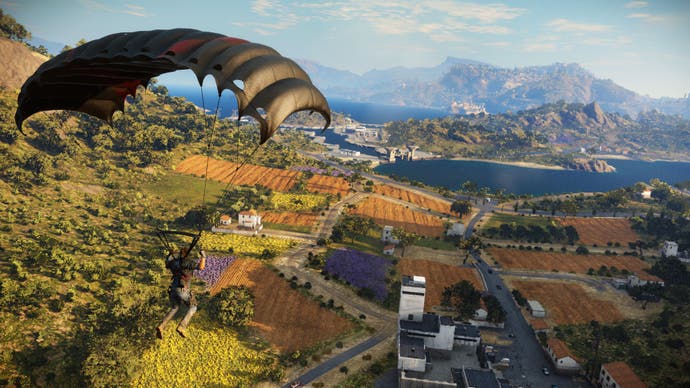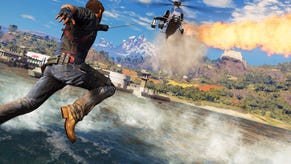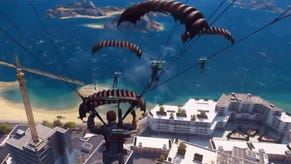Just Cause 3's new brand of chaos, and its (asynchronous) multiplayer
Total Rico.
"A lot of people are using the open world as a big level and putting their single player experience through it," says Just Cause 3's director Roland Lesterlin as we huddle in the warmth of Avalanche's Stockholm offices away from the lashing cold of a January snowstorm. "That's great - I love playing open world games. Just Cause is something a little bit different from that, though.
"I always imagined when I was 12 years old - I tell this story a lot - when you're 12 you're smart enough to understand adults, but you're smaller than them. People are big, cars are big, the sky is big and everything is new. Just Cause has that joyfulness of being 12, and that's something only games can give you. That's where I think it sits, off on its own. It really is a sandbox about creativity. It's a whole bunch of tools, all these weird ideas we've had that all interlink, and then it's, 'what do you make of it?'"
After 45 minutes of fooling around in Just Cause 3, the new instalment in Avalanche's boisterous open world series that's being built over in its New York studio, Lesterlin's point comes back to me again and again. First it's through the fumbling, the initial frustration at not being able to make this world bend to my will and then, when all those systems finally click into place and I'm able to propel myself from one point of the map to another, it's in the heady, giggling glee of it all. One thing's for certain, though. I don't recall being quite as much of a dick when I was 12 years old.
Rico Rodriguez, the brilliantly blunt tool in all this action, is nominally the saviour of Just Cause 3's fictional Mediterranean island Medici, freeing it from the clutches of General di Ravello. The slouched shoulders of the citizens that walk through occupied cities might have less to do with the dictator, though, than with Rico's tendency to tether them to cars, buildings or each other, snapping them together with the new elasticity of his grapple hook before parachuting out to the next town to do it all over again.
Rico's a peculiar hero, and he always has been. That's no different in Just Cause 3 - the tone is still one of campy, excessive fun, where it feels completely right to tether a soldier to a gas cylinder and then watch as they're both blown sky high - and this most definitely isn't a moodier, more serious turn for Avalanche's series as it finds itself in the hands of a new team. The concern this time out is simply making that anarchic action Just Cause has built its reputation on more fluid than before.
You feel that when playing with Rico for the first time: using the grappling hook to ping from buildings to moving cars to pretty much any where you want to go is less cumbersome than before. Find yourself on a ledge and you'll just have to push up to scale it rather than hitting jump, and there are more seamless transitions thanks to an added 2500 animations. The parachute's a more capable partner, too, its flight stabilised to make it that much easier to fire weapons as you're descending through the air, but it's in danger of being upstaged by Just Cause 3's most significant addition.
It might not be the biggest open world out there, but Just Cause 3 doesn't play that sort of game. See that mountain over there? Yes, as you've likely been told so many times before, you can go there, but what's important in Avalanche's knockabout take on open worlds is how you can go there. Traversing the expanse of Medici, which with its lavender fields, big blue ocean and craggy valleys feels just like an OutRun level, is best done with the new wingsuit that has you soaring across this colourful island. The helicopters and sportscars that are at your disposal elsewhere seem so pedestrian in comparison.

The wingsuit promises grace, which it certainly can deliver in capable hands, but it's even better at creating some of that rich slapstick that makes Just Cause such a treat. 20 minutes into my demo, with a little undue confidence, I took a bright yellow Lamborghini-like to see how the new handling fares - there's still a stiffness there combined with slides that are a little too violent, though it's still a part of the game that's very much in the balance - when an unsighted, broken bridge suddenly saw the road fall away. A minor nuisance when it's so easy to disembark from the plummeting car and set a course for the skies, gliding away as it crashed into a canyon and smugly basking in my escape for ten glorious seconds before all that elegance was smeared on rock as I face-planted into a cliff.
The slapstick is, if anything, more pronounced. You can tether three objects now, banding them together by clicking down on the left stick, and Chaos objects - the things that blow up to glorious effect - are now physics driven, a feature artfully demonstrated as a spherical gas cylinder rolls down a hill before erupting into a fiery ball. It's a wilfully chaotic game, this, one that begs you to push at its edges and find something new, something crazier than the development team have managed themselves.
It's what makes playing Just Cause like having debug mode on permanently, where you're always pushing to see what's possible as you conjure up tanks and rocket launchers while the game counterbalances with more and more armed forces and, somehow, it doesn't break. "There are certain things you do developing a game that are really fun," says Lesterlin. "You might just spawn a tank, because you really want a tank. And you're thinking, if I'm having this much fun, why not give it to the player? You've got to balance the game so you can't break it, but we look at some of the things we do as devs and think that's so much fun it should probably be a system in the game."
It seems a bit dull, then, to talk about something as pedestrian as structure amidst all this chaos, but Just Cause 3 is subtly changing the way it handles missions and progression in the game. "It's hard to say that it has structure," says Lesterlin. "There are missions that drive you through a storyline, and we try to give you a bit more depth so you can understand who Rico is. Really, it's still about systems. We're not scripting a mission that's going to give you a different experience to outside that mission. If you can do something in a mission, you can do it in the open world. A mission is just a structured opportunity to try all the weird things in your game."

"We've got missions," adds principal designer Francesco Antolini. "The point is, you have the basic system mechanics of Just Cause, which means liberating settlements. You're free to liberate settlements as you wish, in the order that you want. At the same time, a bit different to Just Cause 2, Just Cause 3 is going to feature a proper mission structure. The philosophy behind the missions is exactly the same in that you're seeing these systems - we give you goals, but there are endless ways you can undertake to satisfy these goals. How do we make that fit within the structure? It's really hard, but that's what makes it interesting from a design perspective to make a game like this. It's really hard, because when you give that much freedom to a player, it's really easy for them to break your mission. There are 10,000 things for you to consider while you're doing that. I hope that we manage to."
Just Cause 3 embraces chaos though - as has been widely noted since its announcement - it's not embracing the kind of chaos seen in the well-received, widely played mod for Just Cause 2 that introduced multiplayer. It hasn't been possible for the team in New York, because the focus is elsewhere. "When you start with multiplayer - there are so many great multiplayer games out there, and it's a core focus of those companies to do multiplayer," says Lesterlin. "For us it's really important not to lose polish on a big triple-A game. It's great in a mod, but you can't ship that mod. You can't have something that's broken and crashes. It's funny in a mod, and it's sweet. We'd have to really spend another layer to make sure we do it right, and right now the focus is to make sure we've got that sandbox right."
There will be multiplayer, of sorts, in Just Cause 3 - an asynchronous solution that has various challenges and associated leaderboards. While it's more ordered than the well-received mod, it's got a flavour that's unique to the series as you take a wingsuit or a car and carve your own racing line across a series of designated checkpoints. It's not, perhaps, what many had in mind for the sequel, but it's a small improvement on Just Cause 2's feature set that'll do just fine until the community has its way with the new game.
The improvements and additions might seem modest - perhaps a symptom of this coming from a new team while the studio at Stockholm busies itself with getting the new Mad Max game ready for launch later this year - but they come together to create a spin on Avalanche's formula that's in step with modern standards. And regardless, even though there are a lot of open world games coming out this year, no matter what happens, none of them will be quite like Just Cause.
This article is based on a press trip to Stockholm. Square Enix paid for travel and accommodation.










